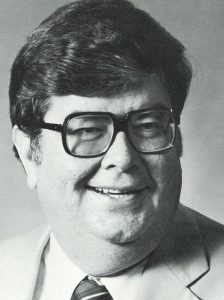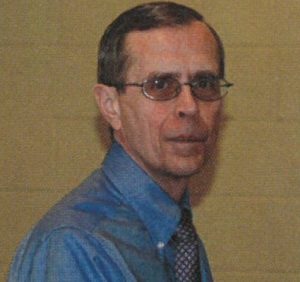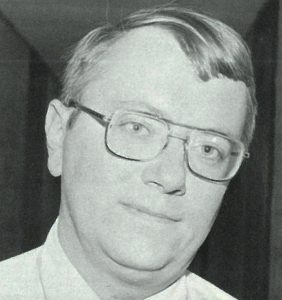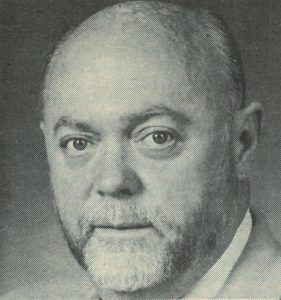By Tom Ward
Thomas More University
Part 41 of Our Series: “Retrospect and Vista II: Thomas More College/University, 1971-2021”
Thomas More College’s 1972-1973 General Information Bulletin for the Department of Business Administration provides a good summary of its goals at that time: Its programs were intended to develop in students the knowledge and also “skill in scientific analysis of problems” and “wisdom in making moral judgments”; overall, “Emphasis is placed on preparing ‘the generalist,’ one who has a broad overview of the entire management function …” (General Information Bulletin, 1972-1973, TMU Archives).
These statements — especially the employment of terms such as “scientific analysis,” “moral judgments” and “generalists” with a “broad overview” — almost sound like they were formulated to meet objections regarding the Commerce Division that President Murphy had voiced ten years earlier in his February 19, 1962 memo to that division’s faculty.

Thomas Coffey, President of TMC, 1982-1986 (TMC Archives)
The title “Commerce Division” disappeared from the college catalog for the 1976-1977 academic year, though the departments that comprised it retained their standard focus through the end of Dr. Robert Giroux’s presidency. Further developments would await the arrival of Dr. Thomas Coffey as the new president of the college in Fall 1982.
Dr. Coffey’s tenure as president was relatively short (1982-1986), yet eventful. He made one of his far-reaching decisions in 1984 when he charged the entire faculty with revising the core curriculum of the college. That decision and its results are explained in Part 25 of this series.
By the time of Dr. Coffey’s presidency, the old Commerce Division was composed of the departments of Business Administration (with Economics), Accountancy, and Computer Science (Coffey to Joint Study Committee, Sept. 5, 1984, TMU Archives). Far from dismissing business as a secondary field of study at TMC, Dr. Coffey wanted to upgrade it. In September 1984, Dr. Coffey sent a formal charge to the three departments. He stressed that it was “imperative” to design a “future-oriented series of programs” that “should attend to the present and future needs in the market place [sic] as well as to the interests and requests of potential students looking to enroll at Thomas More College.” His charge was two-fold: first, they were to evaluate and assess current programs in terms of stated goals and objectives, learning outcomes, the relation of goals to the mission of TMC, resources of full-time and part-time faculty and support staff; second, to design a combined center and program for applied management with a combined program of the three departments.
The idea of a “management center” was key in his thinking, which was something that Professor Donald Ostasiewski also favored. This was not something extraordinary that Dr. Coffey was asking of them—he stated that their charge “dovetailed” nicely with the “College-wide curriculum revision projects” (Coffey cover letter accompanying his charge, Sept. 5, 1984, TMU Archives).

Professor Donald Ostasiewski, Department of Business Administration (TMU Archives)
Dr. Coffey sent this charge to a joint study committee (JSC) composed of members of the departments and chaired by Professor Ostasiewski. He thought its work should be completed by March 15, 1985, although he also requested interim reports. The work of the committee did not proceed smoothly from beginning to end, and there were occasional tensions between the committee and the president, especially regarding the time it was taking the committee to conclude its task.
The JSC’s first interim report of January 1985 cast some of the blame for their slow progress on Dr. Coffey’s delay in giving them their charge, which prevented the JSC from starting their work during the less busy summer months. As part of the study process, they hoped to create a survey with which to interview area business leaders to help in “determining the nature of the market for our future graduates” (Progress Report from Ostasiewski to Coffey, Jan. 15, 1985, TMU Archives).
Dr. Coffey’s overall plan was more ambitious than simply upgrading the business-related curriculum. From the beginning, he planned that the study report would be reviewed by an independent body, but he also had a longer-term goal for a special committee that would include “distinguished businessmen.” Dr. Coffey’s letter to one such businessman, Dennis J. Sullivan, President of Cincinnati Bell, was indicative of his plan. This committee with business leaders would help “design new directions for the College’s programs” that could even become “the basic model for business education in liberal arts colleges throughout the country” (Coffey to Sullivan, Oct. 7, 1984, TMU Archives).
Such a process was necessary because TMC’s administration and Board of Trustees “have become concerned about the quality and effectiveness of the existing programs, the public’s perception of these programs, and the enrollment patterns within these programs.” What he envisioned was a program “which blends its primary academic thrust of the liberal arts with appropriate business and business-related technology education and in so doing, to educate men and women prepared to accept professional roles of leadership in the business community” after receiving an “education deeply rooted in moral and ethical values and which fundamentally interrelates these areas with a solid, imaginative, and practical basic education in business and technology” (Coffey to Sullivan, Oct. 7, 1984, TMU Archives). In this, Dr. Coffey was basically rephrasing the same concern expressed over the decades that business education must adhere to liberal arts standards.

Dr. Charles Bensman, president of TMC, 1986-1992 (TMC Archieves)
As the JSC was finishing its work, the idea of a “management center” was the focus of much attention. For various reasons, the JSC’s work carried on well beyond its original March 15, 1985 deadline, and it eventually abandoned the survey of businesses because it would take too much time. On June 6, Mr. Ostasiewski met with Dr. Coffey and Rick Kleckner, Director of Institutional Advancement, to update them on the nearly completed JSC report, which when finalized would go before an advisory committee for review. Although he had liked the “center” idea, Ostasiewski thought it best that, after the self-study of each department, accountancy, which had its own “niche”, should remain separate, and computer science should merely “incorporate curriculum suggestions from Business and Accounting.” As for Business Administration itself, the department “would probably recommend that its curriculum should be based on two concepts—strategy and entrepreneurship” (Report of meeting between Ostasiewski, Coffey and Kleckner, June 6, 1985, TMU Archives).
As Professor Ostasiewski reported, one of the chief concerns among faculty of the three departments was that the formation of a center could mean that “they might be losing the impact of their separate votes on issues if they were replaced by only one vote of a director of a ‘center.’” Dr. Coffey assured him that this would be taken into consideration so that their votes would not be adversely affected (Report of meeting between Ostasiewski, Coffey and Kleckner, June 6, 1985, TMU Archives).
By September, Ostasiewski was able to present the final 280-page report of the JSC. An abstract of it, dated September 18, 1985, highlighted an ongoing problem (or at least the perception of a problem)—even though the business-related departments, especially business administration, were the “cash cows” of the college, and with the “enrollment picture” more positive than data previously suggested, they were nonetheless “substantially weakened by a severe lack of resources in virtually every area” (Abstract of JSC Report, Sept. 18, 1985, TMU Archives).

Dr. George Euskirchen, Department of Economics. (TMU Archives.)
In regard to curricular revision, Ostasiewski recognized the importance of maintaining the “rational model” (those elements that were amenable to the liberal arts emphasis) while also developing “entrepreneurial values and skills.” Since “no clear future scenario has emerged nationally with respect to management education,” their resultant analysis of the current situation showed “an insufficient base for the immediate launching of an ‘experimental’ program.” They suggested, however, that the departments should design marketing efforts that would be “geared toward the working adult” (Abstract of JSC Report, Sept. 18, 1985, TMU Archives).
The most innovative suggestion was that they should create a “corporate college” (with a coordinator) as a “contractual relationship with small and medium-size Greater Cincinnati businesses”; “If necessary appoint a Director for a combined unit to whom chairpersons and a Corporate College Coordinator could report” (Abstract of JSC Report, Sept. 18, 1985, TMU Archives). This seemed to be a description of the kind of “management center” that Coffey had in mind (Ostasiewski to Coffey, Oct. 17, 1985, TMU Archives)
.
The Board of Trustees was undoubtedly already aware of Dr. Coffey’s plans, but at the board’s meeting after the final JSC report, they directed the president to form a “panel of distinguished business persons along with selected individuals from Thomas More College to study the current curriculum, staff, and resources …” of the three departments. The goal for the panel was to “draw together these three departments into a College programmatic center of business and professional education—a center which will reflect the Mission of the College as well as the current and foreseeable demands on business, accounting, and computer technology within our society.” These directions were to be acted upon, if possible, for 1986-1987 (Resolutions of Board of Trustee meeting, Sept. 19, 1985, TMU Archives).
The liberal arts focus for business curriculum found an ally among a population from whom it might not have been expected—business people. As the board directed and as he had intended all along, Dr. Coffey formed a committee of business leaders to help plan a management center. In an introductory meeting (that included Dr. George Euskirchen of the Department of Economics) held on October 26, Dr. Coffey said he was concerned with enrollment decline and asked their opinion on “how to return to the tradition of a strong liberal arts education and relate that to professional education for a career.” This meant that whatever the panel might create, it should “be a very strong integration of liberal arts and business” (Minutes of meeting of the Commission for the Design of a Center for Management Technology, Oct. 26, 1985, TMU Archives).
More than one of the business attendees expressed their appreciation for a liberal arts education; their remarks are quite instructive. One believed that his own college education “did not help him to succeed up the corporate ladder” and that what businesses really wanted were students who know “how to think, how to deal with people, and to deal with decision making.” A second one added that he felt students “should get their undergraduate degree in liberal arts and then follow with skill development in graduate school.” Yet another agreed with this by opining that as time goes on, employees rely more on liberal arts they’ve learned than on technical skills (Minutes of meeting of the Commission for the Design of a Center for Management Technology, Oct. 26, 1985, TMU Archives). These were things that Dr. Coffey was undoubtedly gratified to hear since he was hoping that this new committee would actually help design the new program center that would integrate the three departments.

Dr. Peter Thornton, associate academic dean and chair of the Business Division, in 1991 (TMU Archives)
Dr. Coffey, however, did not stay at TMC long enough to see this plan through to fruition (he departed in January 1986), though that did not mean that the plan was abandoned. Professor Ostasiewski definitely did not give up on the idea of a center or a new division. According to Ostasiewski, Dean Dr. Raymond Hebert requested in 1987 that he provide a “more complete statement of my proposal regarding the restructuring …” of the three departments. In a reply memo to Dr. Hebert (of which he sent a carbon to acting president Dr. Michael Bromberg and new president Dr. Charles Bensman), he described the process of restructuring: after the JSC report had been reviewed by the “select committee of business leaders,” the outgoing and interim administrations, and the Board of Trustees, “the conclusion was reached that the lack of adequate resources was central to those departments’ difficulty in reaching their full potential. Seen as equally important was leadership and structure.” Among the most crucial components of the required resources were “upgraded computer assets …” and “computer integration into the curriculum …” (Ostasiewski to Hebert, July 24, 1987, TMU Archives).
When Ostasiewski went on to describe the strategy as of January 1987, he noted that it fell short of what was needed and that enrollments were “unstable”; further, there was a “lack of effective management, development, support and delivery systems for the degree programs ….” His main recommendation for a revised structure was to “create a moderately autonomous division” with the near-term goal to develop “market-oriented product lines.” Ultimately, this should “justify the conversion of the division into a college of business administration” which would have a dean to whom the department chairs would report (Ostasiewski to Hebert, July 24, 1987, TMU Archives).
As Ostasiewski continued to press his case with Dr. Hebert for a new division that would be comprised of accountancy, business administration (with economics), and computer science, Dr. Hebert, as dean of the college, was also communicating with the chairs of the departments. By speaking with the chairs of accountancy, Thomas Gilday, and of computer science, Kenneth Taylor, Dr. Hebert learned that they were not entirely onboard with “our division concept as presented.” They felt that Ostasiewski was not consulting them enough before decisions were made (Hebert to Ostasiewski, April 4, 1988, TMU Archives).
Apart from difficulties finding a physical location on campus or funding for a division, Dr. Hebert was convinced that disagreements between department chairs showed that there “is too much ‘emotional baggage’ and too many memories …” and he feared “trying to move forward without the unanimous support of all three departments ….” And even though he believed that the time for a division was not right, he had “great faith and confidence in our current faculty in those three departments,” though they would need to proceed on the basis of a “consensus building” model (Hebert to Ostasiewski, April 7, 1988, TMU Archives).
Dr. Hebert further assured the division chairs that the administration strongly believed in the divisional direction, and he encouraged them to meet together so that “when it is done it is done right.” The division structure would also be crucial “if we are to remain viable in the Continuing Education market” because business-centered courses were the most popular among non-traditional students (Hebert to Accountancy, Business Administration, Computer Science Faculty, April 8, 1988, TMU Archives).

Professor Kenneth Taylor, Department of Computer Science (TMU Archives)
The division plan moved forward with the formation of a Division Committee made up of Dr. Euskirchen of economics, Gilday of accountancy, Taylor and Tom Hext of computer science, with Hext as chair. This committee was tasked with studying the feasibility of putting the three departments into “an educational division.” They completed their study at the end of 1989 and sent a report to Dr. Hebert early the next year. By then the purpose of the division committee seemed to have changed from conducting a “feasibility study” to designing “an implementation strategy.” Their recommendation was the formation of a “School of Business,” which could perhaps be viewed as a scaled-back version of the earlier idea of a management center. The proposed business school or division would have the “autonomy necessary to achieve and maintain a state-of-the-art positioning within the educational and business community.” At any rate, “The faculty universally supports the implementation plan proposed in this document,” though the plan would have to be approved by Faculty General Assembly (Division Committee Report, Jan. 7, 1990, TMU Archives).
The Business Division was finally implemented for the fall 1990 semester. A non-faculty member was brought in from outside TMC to chair the division, Peter Thornton, who was close to completing his PhD; one of SACS’s (Southern Association for Colleges and Schools) criteria was to have more faculty with terminal degrees, so Thornton’s eventual doctorate was a point in his favor. He was also appointed by President Bensman to be associate academic dean to report to Dr. Hebert, while the business-related department chairs would all report to him. Bringing in an outsider for this important new position was not looked upon favorably by all faculty (Recollection of Dr. Hebert, April 7, 2022).
Thus, the Business Division was already in place in 1992 when Dr. Bensman floated the idea of a structural change at TMC by creating two or three other divisions, which would include Divisions or Schools of Liberal Arts (or Arts and Sciences), Nursing, and the possible addition of Education. This development, however, has been explored previously in Part 28 of this series. See https://nkytribune.com/2022/01/our-rich-history-thomas-mores-president-dr-charles-bensman-the-later-years-1989-1992/ All that needs to be said here is that the Business Division was already functioning as an example of what could be done. But Dr. Bensman’s plan for other divisions was vociferously rejected by the faculty, and this rejection may have been part of his decision to resign from TMC in the spring of 1992.
The 1990s brought very significant changes for the business-related departments and faculty with the creation of the Thomas More Accelerated Program (TAP), which included both the bachelor of business administration (BBA) and the master of business administration (MBA), though these developments were already examined in Part 30 and Part 33 of this history.
See these NKyTribune History columms: Accelerated program and TAP/masters in business adminstration.
In the 1990s, Dr. Hebert was responsible for hiring four business administration faculty who still teach at TMU: Dr. Robert Arnold, Dr. Lawrence Byerly, Dr. Frederick Chen, and Dr. Christopher Moyer. They have been instrumental in carrying on the traditional high standards set by their predecessors (Recollection of Dr. Hebert, April 7, 2022, TMU Archives). Other business-related departments have also had relative stability, with Dr. Steven Flynn and Maria Mitchell in Accounting, and Dr. Malcolm Robinson in Economics.
The quality of these departments was affirmed in 2014 when business administration and accountancy were accredited by the Accreditation Council for Business Schools and Programs, following a self-study. As President David Armstrong expressed it, “I am so impressed with our faculty who positioned Thomas More College for this accreditation. Our business program is already well known for its superior quality, and now it has been recognized on a national level” (TMC press release, July 7, 2014, TMU Archives). Over the decades, the efforts of many business-related faculty had built the business program into a worthy component of the college’s liberal arts heritage.
These recent faculty members would be part of the new College of Business created when Thomas More attained university status in 2018, though that story will be told in detail in a later article.
Tom Ward is the Archivist of Thomas More University. He holds an MA in History from Xavier University, Cincinnati. He can be contacted at wardt@thomasmore.edu.
We want to learn more about the history of your business, church, school, or organization in our region (Cincinnati, Northern Kentucky, and along the Ohio River). If you would like to share your rich history with others, please contact the editor of “Our Rich History,” Paul A. Tenkotte, at tenkottep@nku.edu. Paul A. Tenkotte, PhD is Professor of History and Gender Studies at Northern Kentucky University (NKU) and the author of many books and articles.
























